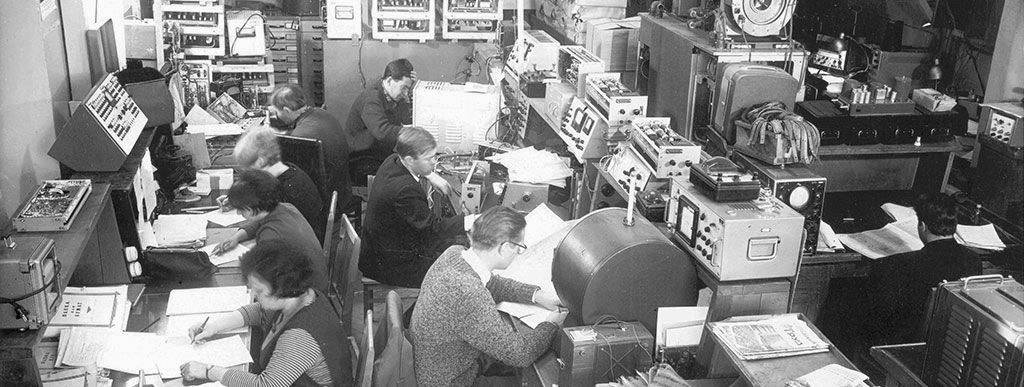История компании

17 января 1950 года — День рождения Компании. ОКБ-275. Системы слепой посадки самолетов
Началом деятельности предприятия считается 17 января 1950 года, когда в составе завода № 275 было организовано ОКБ-275. Его задачей было доведение до серийного производства систем ближней навигации и слепой посадки самолетов, а также монтаж и наладка указанных радиосистем (СП-50, «Курс-МП») на гражданских и военных аэродромах СССР и зарубежных стран, куда поставлялись отечественные самолеты. Коллективом ОКБ в период с 1950 по 1970 годы были смонтированы, построены и введены в эксплуатацию свыше 155 систем слепой посадки на аэродромах СССР и зарубежных стран.
Опыт массовой эксплуатации систем слепой посадки позволил осуществить разработку нового накопления подобных систем: системы «Корректор», «Кросс», «Нефрит», «Нефрит-М». Комплекс контрольно-измерительной аппаратуры «Нефрит» (КИП-ЗГ-4, КПК-5, Рубин-С) по своим тактико-техническим характеристикам позволил обеспечивать посадку по нормам II категории ИКАО. Всего было разработано и внедрено в серийное производство и эксплуатацию 17 наименований приборов различного назначения («Азимут-П», КИП-ЗГ-4, КПК-3, «Рубин-С», ИИЛС, АПН, «Кросс», ИРМ-П и др.).
1953-1964 гг. — УКВ радиопеленгаторы
За период 1953-1964 гг. на предприятии разрабатывались автоматические УКВ радиопеленгаторы различного назначения, включая и радиопеленгатор спецназначения «Буссоль», которые были размещены на всех аэродромах СССР, а также разработанный в 1955 году УКВ радиопеленгатор АРП-6.
1958-1965 гг. — Радиолокационные станции
В ОКБ была разработана РЛС «Раскат» с высокой разрешающей способностью для лоцманской проводки судов в портах со сложной акваторией и большой загрузкой. Эти РЛС были установлены и введены в эксплуатацию в портах Ленинграда, Мариуполя, Одессы. За этот же период времени в ОКБ была разработана аппаратура документирования, контроля и тренажа для автоматизированных систем управления командных пунктов (ДКТ «Протон», «Фаза-13»), а также ряд автоматизированных систем контроля бортового оборудования для различных типов летательных аппаратов.
1963-1988 гг. — ЛКБ «Зарница». Автоматизированные системы контроля
В 1964 году ОКБ было определено головной организацией Министерства радиопромышленности СССР по автоматизированному контролю бортового оборудования самолетов, а в 1966 году выделено в самостоятельную организацию ЛКБ «Зарница».
1974 г. — ЦНПО «Ленинец»
Основным направлением работ в ЛКБ «Зарница» (вошедшем в 1972 году в состав НПО «Марс», а с 1974 года после реорганизации НПО — в ЦНПО «Ленинец») в период с 1963 по 1988 годы стала разработка автоматизированных систем контроля (АСК) для 80 самолетов различного типа. Наземная АСК «Готовность» разрабатывалась с 1964 года как унифицированная система контроля бортовой авионики самолетов СУ-15 и МИГ-25П. АСК «Плутон», разрабатываемая с 1967 года, обслуживала авионику самолета СУ-24.
Последующая АСК «Уран-Т» обеспечивала проверку авионики самолета МИГ-25МП и использовала более современную элементную базу и унифицированные конструкции. На предприятии были развернуты работы по созданию микроэлектронных функциональных устройств, а также осуществлялась отраслевая координация работ в области комплексной миниатюризации РЭА.
1988 г. — Научно-технический центр «Луч»
14 июля 1988 года на основании постановления ЦК КПСС и Совета Министров СССР приказом Министра Радиопромышленности СССР был создан Отраслевой научно-технический центр «Луч», задачи которого включали создание новых радиоэлектронных систем для авиации (самолеты Ту-204, Ту-334, Ил-96-300, Ил-114, вертолеты МИ-8 МТ, Ми-17, Ми-34, Ми-38):
- авиационные метео-навигационные радиолокационные станции;
- радиоэлектронные системы для проводки судов в сложных условиях Арктики и Антарктики;
- системы автономной посадки летательных аппаратов.
Одним из направлений деятельности ОНТЦ «Луч» было создание аварийно-спасательной и медицинской техники для служб экстренной медицинской помощи и структур Министерства по Чрезвычайным ситуациям РФ.
1990 г. — ГНПП «Радар ммс»
В 1990 году приказом Министра Радиопромышленности СССР на базе ОНТЦ «Луч» и филиала ВНИИРЭС «Сектор» было сформировано Государственное научно-производственное предприятие «Радар ммс».
1993 г. — ОАО «НПП «Радар ммс»
В 1993 году ГНПП «Радар ммс» стало Открытым акционерным обществом «НПП «Радар ммс».
2015 г. — АО «НПП «Радар ммс»
В 2015 году ОАО «НПП «Радар ммс» было преобразовано в Акционерное общество «Научно-производственное предприятие «Радар ммс».
АО «НПП «Радар ммс» сегодня
В настоящее время АО «Научно-производственное предприятие «Радар ммс» является одним из мировых лидеров в области создания радиоэлектронных систем и комплексов, точного приборостроения, программного обеспечения.
Награды предприятия
В 2010, 2015 и 2019 годах АО «НПП «Радар ммс» было удостоено Благодарности Президента Российской Федерации «За большой вклад в развитие радиоэлектронной промышленности и достигнутые трудовые успехи». Указом Президента Российской Федерации в 2022 году коллектив предприятия награжден Почетным знаком «За успехи в труде».



